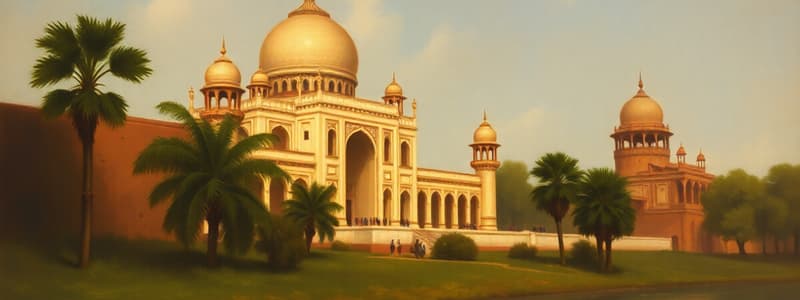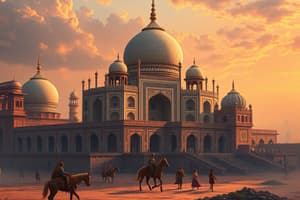Podcast
Questions and Answers
Aurangzeb's policies included a reversal of the previous Mughal rulers' policy of religious tolerance.
Aurangzeb's policies included a reversal of the previous Mughal rulers' policy of religious tolerance.
True (A)
The Mughal Empire experienced significant strength under the rule of Aurangzeb.
The Mughal Empire experienced significant strength under the rule of Aurangzeb.
False (B)
The disintegration of the Mughal Empire began after the reign of Bahadur Shah.
The disintegration of the Mughal Empire began after the reign of Bahadur Shah.
False (B)
The nobles of the Mughal Court gained power as the empire weakened and could control the rulers effectively.
The nobles of the Mughal Court gained power as the empire weakened and could control the rulers effectively.
Bahadur Shah was the last emperor of the Mughal Empire.
Bahadur Shah was the last emperor of the Mughal Empire.
The war of succession began after Aurangzeb's death among his sons.
The war of succession began after Aurangzeb's death among his sons.
The military weaknesses of the Mughal Empire were lessened by the jagirdari and mansabdari systems established by Akbar.
The military weaknesses of the Mughal Empire were lessened by the jagirdari and mansabdari systems established by Akbar.
The many wars fought by Aurangzeb depleted the Mughal treasury.
The many wars fought by Aurangzeb depleted the Mughal treasury.
Hyder Ali established a powerful army in Mysore during the 18th century.
Hyder Ali established a powerful army in Mysore during the 18th century.
Tipu Sultan, the son of Hyder Ali, died in 1801 while defending Srirangapatnam.
Tipu Sultan, the son of Hyder Ali, died in 1801 while defending Srirangapatnam.
Chhatrapati Shivaji Maharaj was born in the year 1627.
Chhatrapati Shivaji Maharaj was born in the year 1627.
The Maratha kingdom reached its peak during the reign of the second Peshwa, Baji Rao I.
The Maratha kingdom reached its peak during the reign of the second Peshwa, Baji Rao I.
The Marathas signed a treaty with the Mughal empire promising to protect it against its enemies.
The Marathas signed a treaty with the Mughal empire promising to protect it against its enemies.
Shivaji and his son Sambhaji managed to escape from imprisonment in Agra by hiding in a basket of sweets.
Shivaji and his son Sambhaji managed to escape from imprisonment in Agra by hiding in a basket of sweets.
The Third Battle of Panipat took place in 1758.
The Third Battle of Panipat took place in 1758.
Ahmad Shah Abdali was responsible for the Maratha decline after the Third Battle of Panipat.
Ahmad Shah Abdali was responsible for the Maratha decline after the Third Battle of Panipat.
The Marathas could collect chauth, which was a quarter of total produce, from Punjab and Sind.
The Marathas could collect chauth, which was a quarter of total produce, from Punjab and Sind.
Sahu, Shivaji's son, appointed his own son Balaji Vishwanath as the prime minister.
Sahu, Shivaji's son, appointed his own son Balaji Vishwanath as the prime minister.
Nadir Shah invaded India in 1739 during the rule of Mughal Emperor Ahmad Shah.
Nadir Shah invaded India in 1739 during the rule of Mughal Emperor Ahmad Shah.
The jagirdari and mansabdari systems were designed to pay soldiers of the Mughal army in cash.
The jagirdari and mansabdari systems were designed to pay soldiers of the Mughal army in cash.
The Asaf Jahi dynasty ruled Hyderabad until it was integrated into the Indian Union in 1948.
The Asaf Jahi dynasty ruled Hyderabad until it was integrated into the Indian Union in 1948.
Saadat Khan was appointed as the governor of Awadh to deal with local zamindar revolts.
Saadat Khan was appointed as the governor of Awadh to deal with local zamindar revolts.
Ahmad Shah Abdali successfully defeated the Mughal forces at the Third Battle of Panipat.
Ahmad Shah Abdali successfully defeated the Mughal forces at the Third Battle of Panipat.
Murshid Quli Khan was the governor of Bengal who owed loyalty to the Mughal Empire only in name.
Murshid Quli Khan was the governor of Bengal who owed loyalty to the Mughal Empire only in name.
Ranjit Singh established a powerful Sikh empire in the 19th century.
Ranjit Singh established a powerful Sikh empire in the 19th century.
The Rajput kingdoms declared their independence as the Mughal Empire was gaining strength.
The Rajput kingdoms declared their independence as the Mughal Empire was gaining strength.
The Jantar Mantar observatory in Jaipur was established by Maharaja Sawai Jai Singh.
The Jantar Mantar observatory in Jaipur was established by Maharaja Sawai Jai Singh.
The British annexed the Carnatic after Ali Khan Wallajah's death in 1765.
The British annexed the Carnatic after Ali Khan Wallajah's death in 1765.
Guru Gobind Singh led the Sikhs against the Mughals during the 16th century.
Guru Gobind Singh led the Sikhs against the Mughals during the 16th century.
The Rohillas established their kingdom in Rohilkhand under Muhammad Khan Bangash.
The Rohillas established their kingdom in Rohilkhand under Muhammad Khan Bangash.
The Battle of Plassey in 1757 marked the defeat of Sirajuddaulah by the French.
The Battle of Plassey in 1757 marked the defeat of Sirajuddaulah by the French.
The Mughal navy was known to be stronger than that of the foreign invaders.
The Mughal navy was known to be stronger than that of the foreign invaders.
Study Notes
Decline of the Mughal Empire
- The Mughal Empire weakened significantly post-Aurangzeb's death in 1707.
- Aurangzeb's lack of political skill and reversal of religious tolerance alienated regional powers like the Rajputs, Marathas, and Sikhs.
- Continuous military campaigns drained the treasury, leading to army demoralization due to delayed payments.
- Successors to Aurangzeb exhibited incompetence, squandering wealth and exacerbating court conflicts over succession.
- Key rulers included Aurangzeb, Bahadur Shah, Jahandar Shah, Farrukhsiyar, Muhammad Shah, and Bahadur Shah Zafar (last Mughal emperor).
Military and External Challenges
- The jagirdari and mansabdari systems, developed by Akbar, faltered under neglect.
- Mughal military was inferior compared to foreign invaders, resulting in vulnerability.
- Nadir Shah of Persia invaded in 1739, causing significant loss and weaken the empire's grip on India.
- The Third Battle of Panipat in 1761 saw Ahmad Shah Abdali defeat the Marathas, further destabilizing the Mughals.
- European powers exploited internal disarray in India to establish control.
Emergence of Independent Regional States
- Fragmentation led to the rise of regional kingdoms, including Hyderabad, Awadh, Bengal, Punjab, and various Rajput states.
Regional Kingdom Highlights
- Hyderabad: Established by Nizam-ul-Mulk in 1724, known for art and culture while remaining nominally loyal to the Mughals.
- Awadh: Governed by Saadat Khan; notable for Urdu poetry and music; fell to British control post-Battle of Buxar in 1764.
- Bengal: Under Murshid Quli Khan's leadership, saw prosperity and was first targeted by British forces after the Battle of Plassey in 1757.
- Punjab: Sikhs, initially opposed to Mughal rule, established a powerful Sikh empire under Ranjit Singh in the 18th century.
Notable Figures and Events
- Shivaji Maharaj: Maratha leader born in 1627, emphasized swaraj (freedom); expanded territory significantly before his death in 1680.
- Peshwas: Balaji Vishwanath and his successors became dominant figures in Maratha governance, especially under Baji Rao I.
- Third Battle of Panipat (1761): Decisive defeat for the Marathas against Ahmad Shah Abdali, leading to British ascendancy in India.
Cultural Contributions
- Maharaja Sawai Singh: Promoted science through Jantar Mantar observatories; significant contributions to astronomy and geometry remain influential today.
- Hyder Ali and Tipu Sultan: Established the Mysore Kingdom, expanding military power and defense against British forces.
Conclusion
- The 18th century in India marked a transition from Mughal dominance to regional powers establishing semi-independent states, paving the way for eventual British colonial rule.
Studying That Suits You
Use AI to generate personalized quizzes and flashcards to suit your learning preferences.
Description
Explore the major factors that shaped India during the 18th century, including the collapse of the Mughal Empire, the emergence of independent regional kingdoms like the Marathas, and the growing influence of British power. This quiz examines the causes behind the decline of the Mughal Empire and its impact on the subcontinent.




